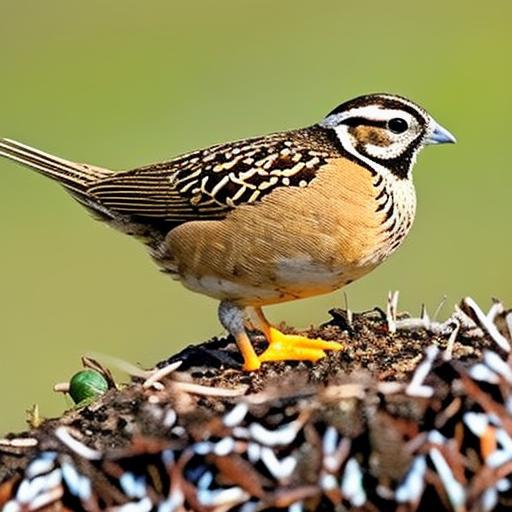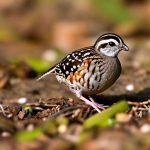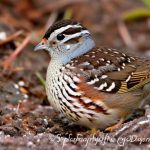Baby quails, also known as chicks, require specific care and attention to ensure their health and well-being. Understanding their needs is crucial for their survival and growth. Baby quails are delicate and vulnerable, so it’s important to create a safe and nurturing environment for them. They need warmth, proper nutrition, hydration, and protection from predators. Additionally, they require social interaction and monitoring to ensure they are thriving. By understanding the needs of baby quails, you can provide the best care for these adorable and fascinating birds.
Baby quails have specific needs that differ from adult quails. They are more sensitive to temperature changes and require a warm environment to thrive. Additionally, they need a diet that is high in protein to support their rapid growth and development. Baby quails also need access to clean water at all times to stay hydrated. Furthermore, they need protection from potential threats such as predators and harsh weather conditions. Understanding these needs is essential for providing the best care for baby quails and ensuring they have a healthy start to life.
Key Takeaways
- Baby quails need a warm, safe, and stress-free environment to thrive
- Provide a balanced diet of high-quality feed and clean water for baby quails
- Maintain the right temperature and humidity levels for baby quails to ensure their well-being
- Handle baby quails gently and minimize stress during interactions
- Regularly monitor the health and behavior of baby quails for any signs of illness or distress
- Gradually transition baby quails to adult care as they grow and develop
Creating the Right Environment for Baby Quails
Creating the right environment for baby quails is essential for their well-being and development. The environment should mimic their natural habitat while providing the necessary warmth, protection, and space for them to thrive. A brooder is a popular choice for housing baby quails, as it provides a warm and secure space for them to grow. The brooder should be equipped with a heat source, such as a heat lamp or heating pad, to maintain the ideal temperature for the chicks. Additionally, the brooder should have a non-slip surface to prevent injuries and provide enough space for the chicks to move around comfortably.
In addition to warmth, baby quails also need protection from potential threats. The brooder should be secure and predator-proof to keep the chicks safe from harm. It’s important to keep the brooder clean and dry to prevent the spread of disease and ensure a healthy environment for the chicks. Providing proper ventilation is also crucial to maintain air quality and prevent respiratory issues. By creating the right environment for baby quails, you can ensure they have a safe and comfortable space to grow and thrive.
Feeding and Hydrating Baby Quails
Feeding and hydrating baby quails is essential for their growth and development. Baby quails require a diet that is high in protein to support their rapid growth. A commercial game bird starter feed is an excellent choice for baby quails, as it provides the necessary nutrients for their development. The feed should be finely ground to make it easier for the chicks to consume. Additionally, offering small amounts of finely chopped greens can provide added nutrients and enrichment for the chicks.
In addition to proper nutrition, baby quails need access to clean water at all times to stay hydrated. It’s important to provide water in shallow dishes or special chick waterers to prevent drowning. The water should be changed regularly to ensure it stays clean and fresh for the chicks. Monitoring their food and water intake is crucial to ensure they are getting enough nutrients and hydration. By providing proper feeding and hydration, you can support the healthy growth and development of baby quails.
Providing Proper Heat for Baby Quails
Providing proper heat for baby quails is crucial for their survival and well-being. Chicks are unable to regulate their body temperature effectively, so they rely on external sources of heat to stay warm. A heat lamp or heating pad can be used to provide the necessary warmth for the chicks. The brooder should be heated to around 95-100 degrees Fahrenheit during the first week of life and gradually reduced by 5 degrees each week until they are fully feathered.
It’s important to monitor the temperature regularly to ensure it remains within the appropriate range for the chicks. Providing a thermometer in the brooder can help you keep track of the temperature and make any necessary adjustments. Additionally, offering a cooler area within the brooder allows the chicks to regulate their body temperature by moving to a comfortable spot. By providing proper heat for baby quails, you can ensure they stay warm and healthy during their early stages of life.
Handling and Interacting with Baby Quails
Handling and interacting with baby quails is an important part of their socialization and development. Gentle handling from an early age can help them become more comfortable with human interaction and reduce stress when being handled as adults. It’s important to approach them calmly and avoid sudden movements to prevent them from becoming frightened or stressed. Additionally, spending time near the brooder and talking softly to the chicks can help them become familiar with human voices.
It’s important to allow the chicks to become accustomed to being handled gradually. Start by gently stroking them while they are in the brooder, then slowly progress to picking them up for short periods of time. It’s important to support their bodies properly and avoid holding them too tightly to prevent injury. By handling and interacting with baby quails in a gentle and positive manner, you can help them become more comfortable with human interaction and build trust with their caregivers.
Monitoring the Health of Baby Quails

Monitoring the health of baby quails is essential for identifying any potential issues early on and providing prompt care. It’s important to observe their behavior, appetite, and droppings regularly to ensure they are healthy and thriving. Any changes in behavior or appearance should be noted and addressed promptly. Additionally, keeping the brooder clean and dry can help prevent the spread of disease and maintain a healthy environment for the chicks.
Regular health checks can help identify any potential health issues early on. It’s important to monitor their weight gain, as sudden changes in weight can indicate underlying health problems. Additionally, keeping an eye out for any signs of illness, such as lethargy, labored breathing, or abnormal droppings, can help you identify any potential health issues early on. By monitoring the health of baby quails regularly, you can ensure they receive prompt care and attention when needed.
Transitioning Baby Quails to Adult Care
As baby quails grow and develop, they will eventually need to transition to adult care. This includes transitioning them from a brooder to a larger coop or pen that provides more space for them to move around freely. The coop should be equipped with proper roosting areas, nesting boxes, and protection from predators. Additionally, transitioning them to an adult diet that is suitable for their specific breed is essential for their continued growth and development.
It’s important to introduce them gradually to their new environment to reduce stress and allow them time to adjust. Providing enrichment activities such as dust baths, perches, and toys can help keep them mentally stimulated and prevent boredom. Additionally, monitoring their behavior and interactions with other birds can help ensure a smooth transition to adult care. By transitioning baby quails to adult care gradually and providing a suitable environment for their specific needs, you can ensure they continue to thrive as they mature into adult birds.
In conclusion, understanding the needs of baby quails is essential for providing the best care for these delicate birds. Creating the right environment, providing proper nutrition and hydration, ensuring proper heat, handling and interacting with them gently, monitoring their health, and transitioning them to adult care are all crucial aspects of raising healthy baby quails. By following these guidelines and providing attentive care, you can ensure that your baby quails have a healthy start in life and continue to thrive as they mature into adult birds.
If you’re looking for tips on how to keep a baby quail alive, you might also be interested in learning about creating a garden chicken coop. A well-designed coop can provide a safe and comfortable environment for your quail and other poultry. Check out this helpful article on poultrywizard.com for valuable insights on setting up a garden chicken coop that can benefit your quail and other feathered friends.
FAQs
What do baby quails eat?
Baby quails should be fed a diet of high-protein game bird starter feed, which can be found at most pet stores or farm supply stores. They can also eat small insects, seeds, and greens.
How often should I feed a baby quail?
Baby quails should be fed small amounts of food several times a day. They have fast metabolisms and need frequent meals to stay healthy and grow properly.
How do I keep baby quails warm?
Baby quails need to be kept in a warm environment, ideally around 95-100 degrees Fahrenheit for the first week, and then gradually decreased by 5 degrees each week until they are fully feathered. A heat lamp or heating pad can be used to provide the necessary warmth.
How do I provide water for baby quails?
Baby quails should have access to clean, shallow water at all times. It’s important to use a waterer that is designed for small birds to prevent them from drowning.
How do I handle baby quails?
When handling baby quails, it’s important to be gentle and to support their bodies properly. Avoid picking them up by their wings or legs, and always wash your hands before and after handling them to prevent the spread of disease.
Meet Walter, the feathered-friend fanatic of Florida! Nestled in the sunshine state, Walter struts through life with his feathered companions, clucking his way to happiness. With a coop that’s fancier than a five-star hotel, he’s the Don Juan of the chicken world. When he’s not teaching his hens to do the cha-cha, you’ll find him in a heated debate with his prized rooster, Sir Clucks-a-Lot. Walter’s poultry passion is no yolk; he’s the sunny-side-up guy you never knew you needed in your flock of friends!







